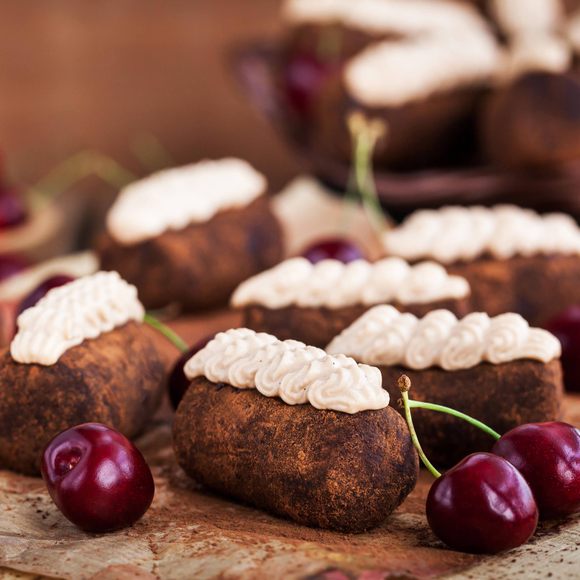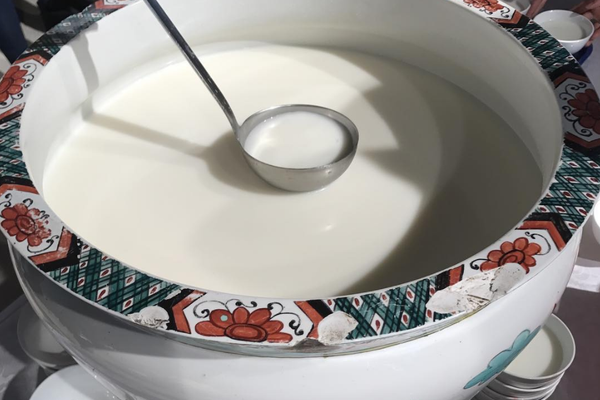Walk into a Russian cafeteria and you’ll likely find two very different types of kartoshka on offer. The word means “potato” in Russian, and there will usually be at least one spud dish available. But you may also see a chocolate “potato” in the dessert case.
These little cakes, sometimes shaped like tubers and decorated with nuts or frosting, don’t actually contain potato. This kartoshka is made from cake or cookie crumbs, typically glued together with butter, sgushyonka (sweetened condensed milk), cocoa powder, and perhaps a splash of rum or cognac. No baking is required—like a truffle, the formed kartoshka just needs to rest in the fridge for a while.
The upcycled nature of kartoshka cakes made them extremely popular in the Soviet Union, where food shortages forced canteen managers and home cooks alike to make ingredients stretch as far as they could. Prior to the Soviet era, some bakeries had already been reworking pastries past their prime into “new” products. But the kartoshka really took off when Soviet industrial kitchens had to document exactly how their supplies were being used. (As one story goes, a pastry chef at Moscow’s Praga restaurant spotted perfectly usable bits of sponge cake going to waste in the course of dessert production, and decided to run these odds and ends through a meat grinder.) Fittingly, one 1950s kartoshka recipe reminds the restaurant or cafeteria cook to make an “appropriate re-calculation” to account for these leftover scraps.
Where to Try It
-
Stolovaya 57
GUM, Krasnaya ploschad, 3, Moscow, 109012, RussiaThis self-service cafeteria on the third floor of Moscow's famed GUM shopping center traffics in Soviet nostalgia and is good for a quick bite while exploring Red Square. Look for kartoshka in the dessert case.
-
This Russian specialty grocery store shares its building with a historic theater. Be sure to check out the offerings at the box office's kiosk on your way inside. The kartoskha is in the refrigerated desserts section.
Written By
 Susie Armitage
Susie Armitage
Sources
- www.olgasflavorfactory.com/recipes/sweets/pirozhnoe-kartoshka/
- thefoodiemiles.com/russian-kartoshka-dessert/
- www.rbth.com/russian_kitchen/2016/01/29/how-food-shortages-in-the-ussr-led-to-a-favorite-dessert_563403
- p-syutkin.livejournal.com/1986.html
- russianchicagomag.com/russian-no-bake-cookies-chocolate-potatoes/
- www.pennappetit.com/2013/02/schokoladnaya-kartoshka-the-humble-russian-dessert/
- www.aif.ru/dontknows/eternal/kto_pridumal_pirozhnoe_kartoshka_i_pochemu_ono_tak_nazyvaetsya
- www.rbth.com/russian_kitchen/2017/06/09/10-yummies-that-all-soviet-children-adored_779932
- books.google.com/books?id=zw9rBgAAQBAJ&pg=PT24&lpg=PT24&dq=%D0%BF%D1%80%D0%B0%D0%B3%D0%B0+%D0%BA%D0%B0%D1%80%D1%82%D0%BE%D1%88%D0%BA%D0%B0+%D0%BF%D0%B8%D1%80%D0%BE%D0%B6%D0%BD%D0%BE%D0%B5&source=bl&ots=2HqAR2mgQ1&sig=ENMrTQpmsbVDIDz4WsIK1V2TkrU&hl=en&sa=X&ved=0ahUKEwial7PUgLnbAhUJ7qwKHQw8D3c4FBDoAQhDMAM#v=onepage&q=%D0%BF%D1%80%D0%B0%D0%B3%D0%B0%20%D0%BA%D0%B0%D1%80%D1%82%D0%BE%D1%88%D0%BA%D0%B0%20%D0%BF%D0%B8%D1%80%D0%BE%D0%B6%D0%BD%D0%BE%D0%B5&f=false
- eda.wikireading.ru/133755












